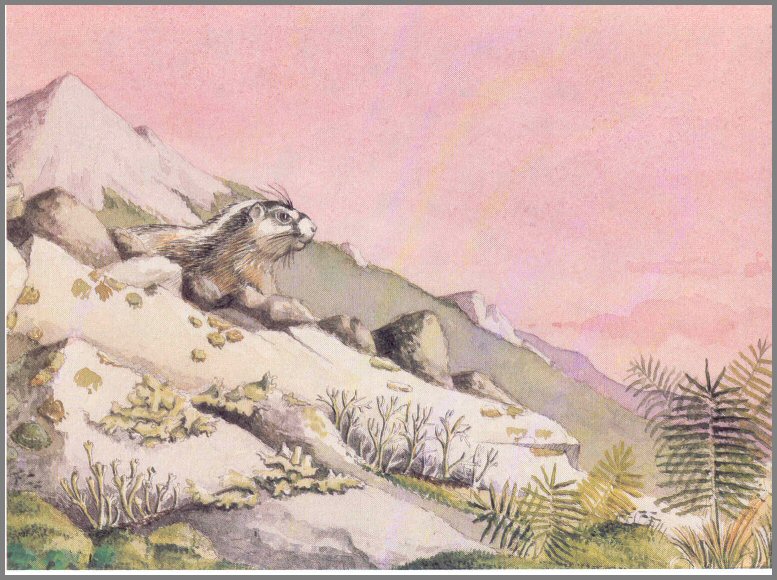
[MA149]Pages 88-116
(It may take a while to download but I think it is
worthy - John A. Keslick, Jr.) A word from the webmaster - Within
this article the word nutrient is misused at times where the true meaning is
essential elements. See my dictionary at
www.treedictionary.com and look up
nutrient as well as essential element. The reason for the latter is to
reduce misunderstanding of terms to better understand the message. John A. Keslick, Jr.
Bare rock
The harsher the environment the longer succession
takes. The conversion of bare rock to forest requires thousands of years
(fig. 33). Succession begins when lichens etch and dissolve minerals from
rock surfaces. When conditions are favorable, this action and the physical
presence of the lichens may provide conditions which allow mosses to grow and
accumulate organic and mineral matter. In this way, sufficient soil can
accumulate to provide habitats for ferns and, later, for grasses and forbs.
There are probably cases where such succession has continued to the point where
shrubs and trees can grow.
Figure 33.-Primary succession in mountains such as the Rockies begins with bare rock. Lichens (left foreground) may eventually create places where mosses (center foreground) can grow. Finally, many thousands of years later, a community of ferns, forbs, and grasses may evolve (right foreground). If conditions are very favorable, a community of shrubs and trees may eventually develop.

Page 88
Grassland
Succession, of course, also occurs in non forest ecosystems, including large
lakes, oceans, and grasslands. Figure 34 shows grassland development on
wagon trails in the western Great Plains after these trails had been abandoned
for different lengths of time. For the bare ground of the most recently
used trails (1) to pass through communities of scattered annual weeds (2),
short-lived grasses (3), and early perennial grasses (4) to the original dense,
stable grass community (5) requires 20 to 40 years.
Figure 34. -Succession on abandoned wagon train trails in the Great Plains. The bare soil ( 1) of the most recent trails first supports scattered annual 'weeds (2), then short-lived grasses (3), and later early perennial grasses (4). From 20 to 40 years after abandonment, the trails once more support the original dense grass climax (5).
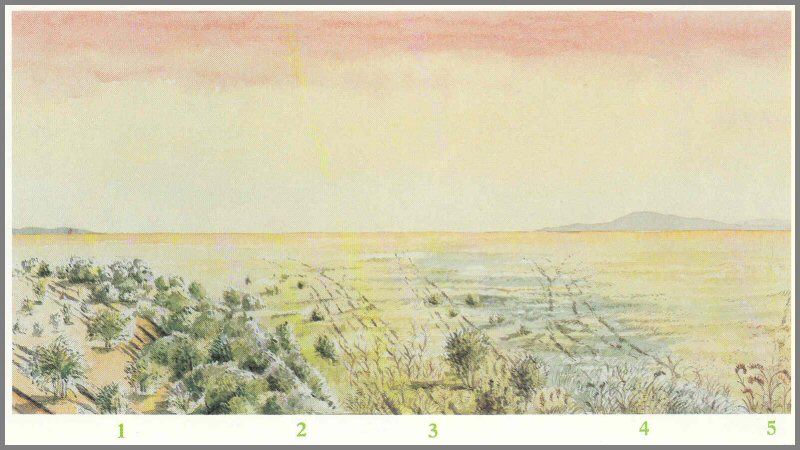
Page 89
Succession also occurs in less visible places. Many different
communities of soil insects and microorganisms developed during the transition
from bare dune sand to the moist organic matter-rich soil of the forest.
Even wounds in living trees, like bare fields, are colonized successively by
communities of microorganisms; this colonization usually begins with "pioneer"
bacteria, followed by staining fungi, and eventually by decay fungi.
Succession of Saprotroph decomposer communities within a fallen tree (fig. 35)
begins when the dead wood is attacked by insects and microorganisms, and ends
when the wood is decomposed by wood-rotting fungi, bacteria, and other
Saprotrophs.
Figure 35. -Succession in a fallen pine tree.
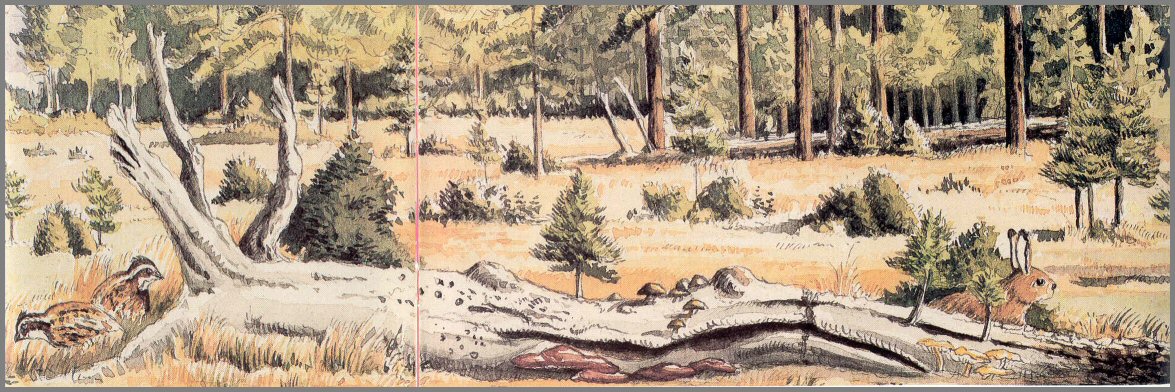
Page 90
FACTORS AFFECTING SUCCESSION
Successions of birds and animals also occur-usually as a result of changes
in the plant community. And animals and birds can significantly affect the
course of succession. Birds and animals often introduce seed from plants
of more advanced stages, and burrowing animals provide habitats of mineral soil
for plants of earlier stages. In mixed plant communities, overbrowsing of
early stage species by herbivorous mammals and insects can speed up succession.
But, overbrowsing in general usually sets succession back to an earlier stage.
Succession also can be set back by other major disturbances -
both natural and human-caused. Fires, hurricanes, and logging operations
are some of these disturbances.
But we might ask ourselves, so what? What is actually happening
ecologically when the Game of the Environment is played by nature's Rules?
Why is this important to people? We can provide some answers to these
questions by comparing the early and late stages of succession.
Page 91
SUCCESSION VERSUS PRODUCTIVITY
In the early stages of community development, materials produced by
photosynthesis accumulate faster than they can be degraded through respiration.
Energy flows primarily by the grazing process in short, simple food chains.
As biotic development proceeds and biomass increases,
respiration also increases; eventually the production of materials by
photosynthesis may nearly equal that being degraded through respiration.
Energy is channeled by complex pathways through intricate food webs that mostly
entail breakdown of detritus by Saprotroph decomposers.
PEOPLE AND SUCCESSION
The characteristics and principles of ecological succession are very
important to us. In most cases, modern agriculture and forestry rely on
holding natural biotic development in check, or interrupting it at some point
and starting it again. Thus, we grow simple communities-often single
species or monocultures-over large areas. Experience has shown that
these systems are very vulnerable. They can be hard hit very quickly by
insects and disease or by drought or other adverse environmental factors so that
we must continually subsidize them with energy in the forms of pesticides,
fertilizers, and fossil fuel. Therefore, to supply the food and fiber
needs of today's population, we must break the Rules of the Game that regulate
the development of natural ecosystems.
At the same time, we are beginning to understand that natural
ecosystems also fulfill needs that are important-the modification of harsh
climates: the cycling of nutrients, and the production of clean water.
And, of course, the recreational and esthetic needs of people are often best
satisfied by natural ecosystems. A logical strategy is to maintain diverse
mixtures of early and later "stages" by compartmentalizing the landscape.
Page 92
---- ---- ---- ---- ---- ----
IN YOUR ENVIRONMENTAL ARENA
For some natural ecosystems in your
area, describe some of the steps that you can see in the biotic development
(succession) of the plant communities.
For your area, list some plant communities
whose development is regulated or held in check by people. How and why are
these communities regulated?
Compare a natural and a people-regulated
plant community in your area in terms of the numbers of different plant and
animal species present, the sources of energy, and the sources of nutrients.
Describe some ways that succession, or
biotic development, has determined your lifestyle or those of members of your
community.
Page 93
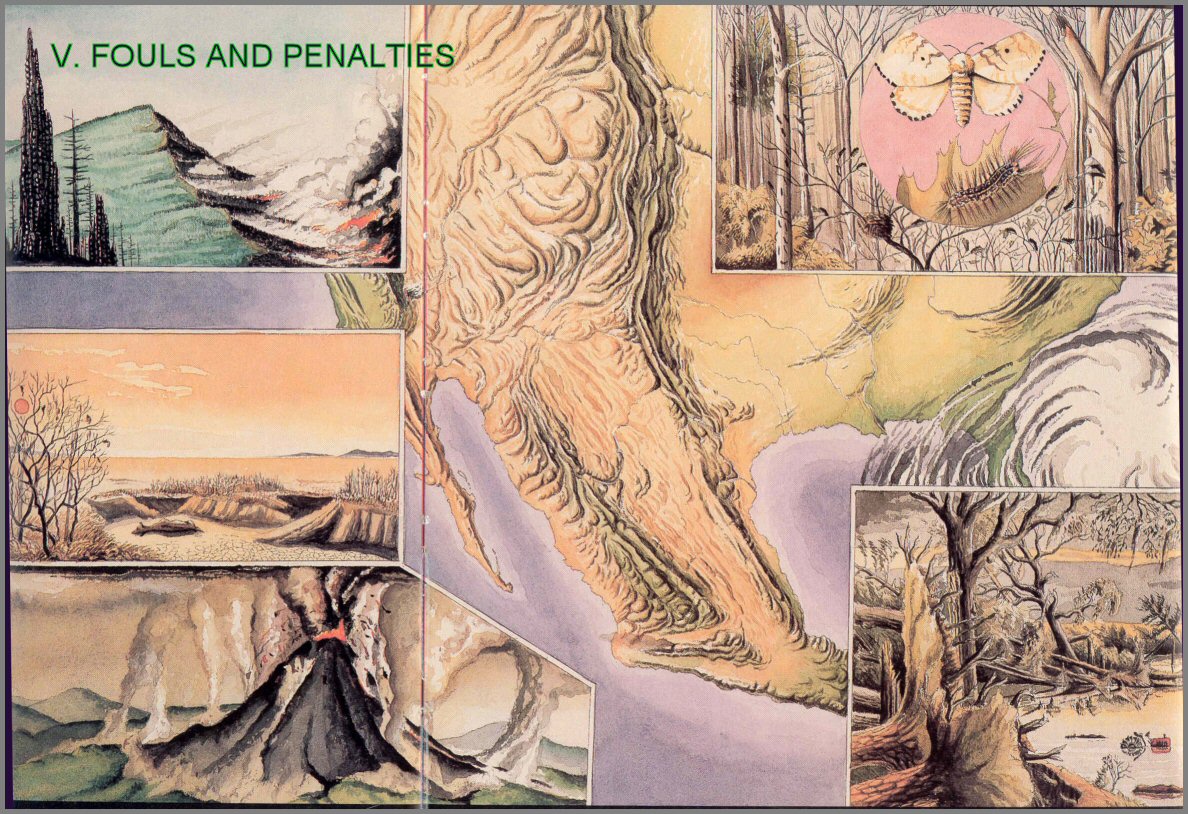
Page 94-95
Figure 36. - Wildfire may be a powerful natural Foul in that it interferes with the nutrient cycling and energy flow Rules. Some natural communities exist because fire "breaks" the Rules.
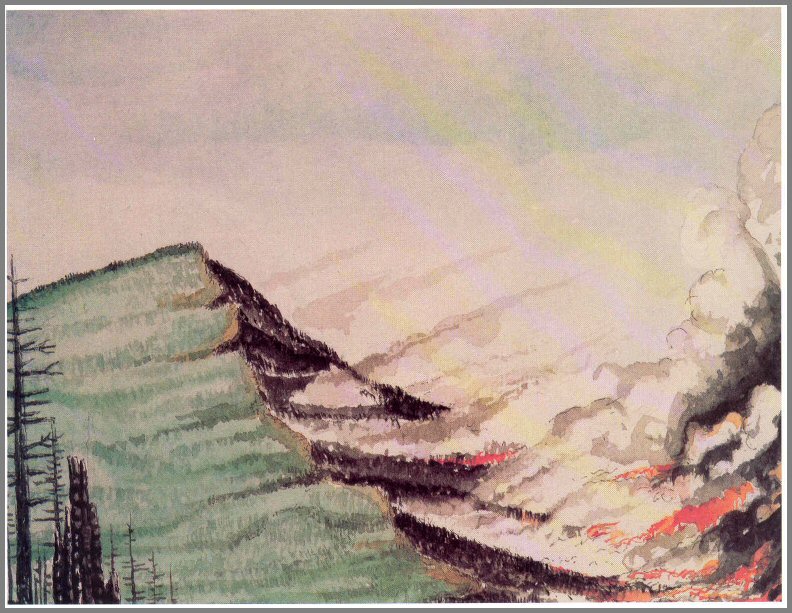
Page 96
SOME OF NATURE'S FOULS
The successional patterns of the natural ecosystems just described occur when the Game of the Environment proceeds unhindered by major upsets. But upsets are common and natural. Defoliation by insects in the Northeast, hurricanes in the Southeast, wildfire in the West, drought in the Plains, and volcanoes in Central and Latin America are some natural events that interfere with (break) the energy flow and nutrient cycling Rules of the Game.
Wildfire
Wildfire (fig. 36) has a powerful influence on patterns of vegetation. Fire
sets back succession and influences species composition. Some species are
favored by fire; others are hindered or are eliminated.
Fire is a major agent in decomposing organic matter and in
recycling nutrients. Periodic fires preserved the vast prairies and oak
openings of yesteryear; they are responsible for maintaining the shrubby
California chaparral, the jack pine forests in the Midwest and in Canada, and
the mixed pine flatlands of the Southeast. The important role of wildfire
in natural systems is now being recognized; under certain circumstances, fire in
wilderness areas is permitted to run its course.
Fire has long been exploited by people-primarily in setting
back succession to a more productive stage. Foresters use controlled
ground fire to suppress hardwoods in pine forests, to create openings and food
for wildlife, and to reduce accumulated litter. Thus the use of fire
prevents catastrophic hot crown fires and perpetuates useful shrub species, such
as blueberry and huckleberry, which serve as food for wildlife and people.
Fire is used to recycle nutrients in grass communities, to eliminate encroaching
weed shrubs, and to reduce the number of disease organisms on stubble and other
plant parts after harvesting.
Page 97
Drought
Drought (fig. 37) also has greatly influenced the development of ecosystems. The severe drought of the 1930's caused widescale alterations in species composition, and major disruptions of communities. As plants died, their roots were no longer able to hold the soil-the result was massive erosion of topsoil rich in nutrients and organic matter. During this period, succession was often set back to "square one" - bare subsoil.
Figure 37 - Severe drought is a natural event that results from disruptions of the water cycle, and that, in turn, interferes with the cycle of nutrients and flow of energy in ecosystems.
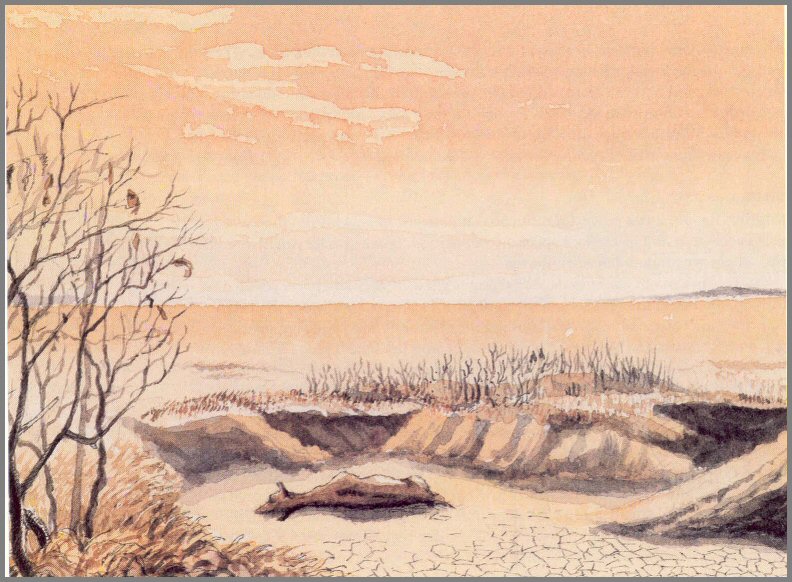
Page 98
Volcanism
"Square one" also is the successional stage after volcanism (fig. 38). Bare volcanic rock may suddenly appear where only minutes before grew lush tropical or subtropical vegetation; also, volcanoes are natural sources of pollution because they emit particulates, heat, and gases.
Figure 38. - A volcano may suddenly and violently set back succession to "square one, ,.. or bare subsoil.

Page 99
Hurricanes
Powerful hurricanes, tracking north and east from their spawning grounds in the Caribbean, periodically "sweep" the forests along the southern and eastern coasts of North America (fig. 39). Records suggest that hurricanes remove the "big trees" of the eastern forests every 100 to 150 years; when this happens in mature climax forests, the light that reaches the forest floor allows light-demanding plants to grow on mounds of soil raised by the tipped roots of the toppled giants. In this way, hurricanes (and other wind storms) create a diversity of species by providing gaps for species that demand light.
Figure 39. - Hurricanes periodically interrupt or influence succession in North America.
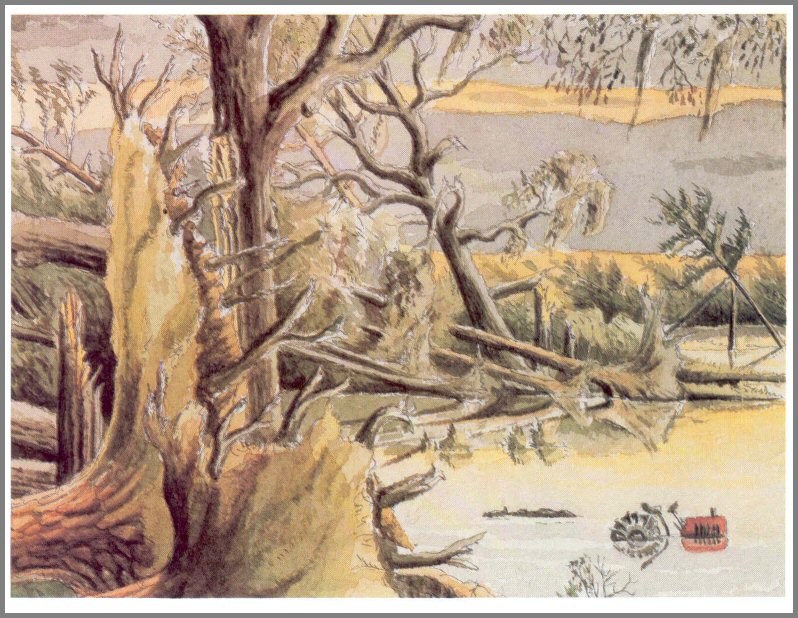
Page 100
Overgrazing (insect defoliation)
"Overgrazing" by defoliating insects also can disrupt natural forest
ecosystems. Defoliation-removing the food-making machinery-seriously
interferes with energy flows. The ingestion of leaves that otherwise would
have fallen and decomposed interferes with normal nutrient cycles.
Periodic severe outbreaks by insects such as the gypsy moth (fig. 40), spruce
budworm, tent caterpillar, and cankerworm can alter species composition
significantly and influence succession.
Repeated defoliation of oaks by the gypsy moth may result in
the death of significant numbers of trees; depending on the site and stage of
development, defoliation also can advance or set back succession.
Figure 40. - Defoliation by insects alters energy flow and nutrient cycling.
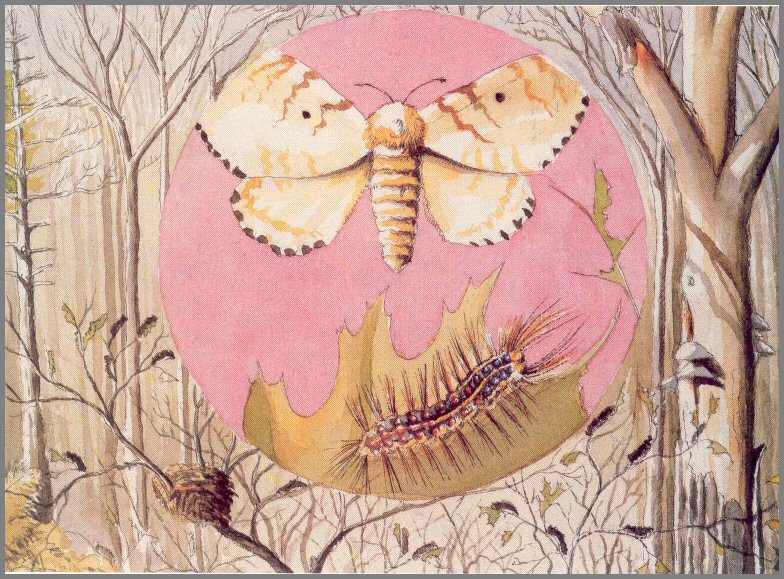
Page 101
Figure 41.-Domestic and wild animals can overgraze their energy and nutrient supplies if they become too numerous.

Page 102
Outbreaks of gypsy moths are frequently associated with a previous
disturbance in the forest caused by humans or nature. Recent evidence that low
populations of this insect are strongly regulated by predatory insects and small
woodland mammals (deer mice and shrews) suggests that disturbances that reduce
predator populations (for example, fire or urbanization) may indirectly trigger
insect outbreaks.
Outbreaks by other grazer Consumers due to the control of
predators are well documented. The unwise destruction of Consumers at the
tops of food chains - wolves, coyotes, hawks, eagles-for sport or for protection
of domestic and wild animals has resulted in explosions of grazing prey
populations (fig. 41). In many instances, the outcome has been overgrazing
and depletion of the range, and the starvation of these "protected" herds.
Similar consequences have followed the introduction -
intentionally or accidentally-of herbivores into ecosystems that have no
predators. Thus populations of the introduced gypsy moth seem to be
explosively higher where the insect moves into new territories than where it has
been established for many years. When plotted, such population patterns
typically follow a J-shaped growth curve, the population rises exponentially
until the resources of the environment suddenly become limiting. When this
point is reached, the population usually crashes to a low point. With
time, subsequent oscillations in populations of some organisms may become less
violent, and population levels fluctuate near the maximum number that can be
supported by the given habitat. This population level is known as the
carrying capacity.
Page 103
Carrying capacity is an important concept. Basically, it tells us
that there can be only so many Players of one kind in an Arena. The
J-shaped curve is the growth form of populations not responsive to the carrying
capacity. Often, however, increasing populations do respond to increasing
environmental limits. In these cases, the shape of the population growth
curve is an S; it begins slowly, then increases rapidly, and later, as resource
limitations provide negative "feedback," levels off near the carrying capacity.
It is important to point out that outbreaks of native insects
occur periodically, and that they may contribute in major ways to the
development of an ecosystem. In the terminology of our Game, these
Consumer Players, by interfering with the flow of energy and nutrient cycling
(excessive grazing versus the normal slow decomposition of detritus), can alter
succession. Outbreaks of the spruce budworm, like fire-in the jack pine
forests, are believed to be the primary agents responsible for periodically
killing off, renewing, and thus perpetuating the northern spruce-fir "forest of
catastrophe."
The human need for a predictable and continual supply of wood
led to attempts to alter these natural outbreaks - primarily by controlling
insect populations with chemicals. But wide scale use of certain
pesticides brought other adverse effects (see pages 132 and 133).
IN YOUR ENVIRONMENT ARENA
List some other natural events (Fouls) that have interfered with energy flows or nutrient cycles in our country.
What natural Fouls have you encountered in your community?
In what ways have they interfered with the Rules of the Game?
Describe the ways in which succession could have been affected by one of these events.
How have people's activities or plans been influenced by natural events in your area?
Page 104
SOME PEOPLE FOULS
Like nature's Fouls, the adverse effects of human actions are primarily due
to interfering with and breaking the Rules of the Game-to messing up the natural
order of things. Our general view of these environmental "problems" is
intended to serve not as a warning of impending doom but as a guide for future
action. We have an unequaled capacity to wreak havoc with our environment
and, therefore, to endanger ourselves. But we also have the
capacity-unique among all creatures-to evaluate and correct past mistakes.
Our future course must be guided by hindsight-and by an understanding of
ecological relationships.
The unparalleled ability people have to "move things about"
has created adverse and complex situations that must be faced by future
generations. Figures 42 through 58 summarize some of our Fouls and
Penalties as we manipulate ecosystems, deplete finite resources, and
pollute our environment. That all of these actions are closely
interrelated emphasizes once more the interdependence of ecosystems and of
events within them.
Page 105

Page 106-107
Figure 42. - People often move too much, too often, and in too little space. Domestic and industrial development of the flood plain and improper strip mining on the hills above can create serious flood and siltation problems.
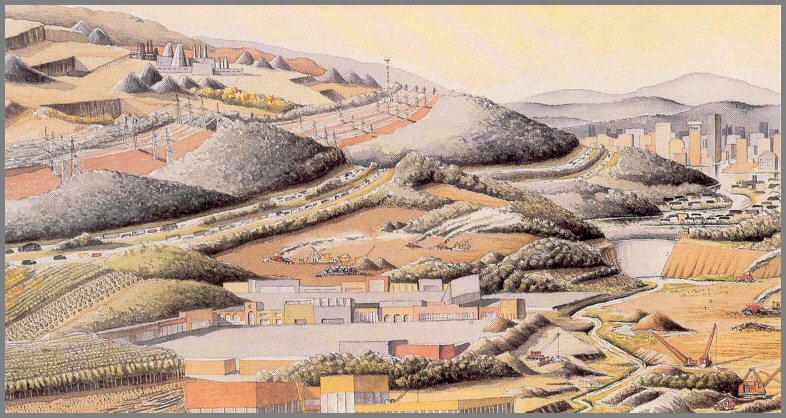
Page 108
Manipulation of ecosystems
Disruption of flood plains
Let's consider the following scenario centered on the City and the river around which it was built (fig. 42). Initially the source of power, transport, food, and water (upstream) and waste disposal (downstream), the river is now a "problem." Encroachment by buildings, shopping centers, and highways onto the river's flood plain have created a flood problem; this requires the construction of a dam-the "solution." But siltation behind the dam from upstream developments is now decreasing the effectiveness of the dam. Downstream, the false security created by the dam's presence encourages further clearing, filling, and developing of the convenient flood plain land and the surrounding watershed. Housing developments and industrial complexes encroach even onto the salt marshes. Destruction of the marsh "nurseries" brings about the demise of the once thriving sport fishing of the harbor. And runoff from nonabsorptive surfaces and erosion accelerates silting of the harbor-a problem that is "solved" by dredging.
Dredging and dumping
But a new problem arises: what to do with the dredged spoils?
Previous solutions, returning the spoils to land to fill "waste spaces" such as
wetlands or dumping them at sea, are now questioned because of their adverse
environmental impact.
Page 109
Figure 43. - Outbreaks of diseases and insects (group of yellow trees on hillside, left center) can occur when trees are rendered susceptible to them by factors such as pollution. This can be especially serious when too much of the same crop is grown in one area.
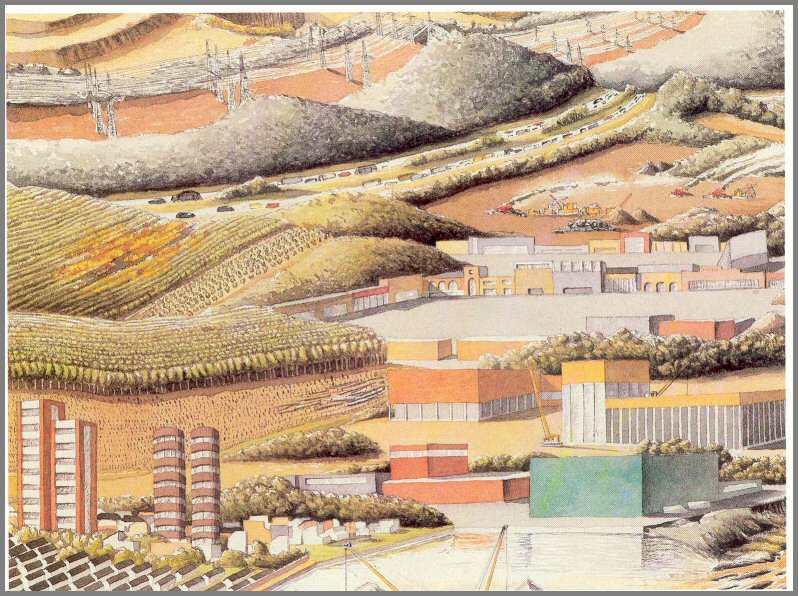
Page 110
Growing monocultures
In trouble now are the farmlands and the forest. Agriculture is
relegated to less fertile land above the flood plain; farmers and foresters are
forced to focus only on a few productive species. The growing of a single
species to the exclusion of others on a large area is known as a monoculture.
There are outbreaks of bark beetles (fig. 43) in the pine
forest monocultures weakened and predisposed to insect attack by air pollution,
especially that from automobile exhausts. Harvests are now being conducted
to salvage the dead and dying trees. Improperly installed logging roads
used in this operation augment erosion and silting of the harbor. Air
pollution also affects the agricultural food crops "downwind" of the city.
Impacts on the city's food source will be great if the monocultures are
susceptible to the high levels of oxidents reached during "episodes" of
inversion (air trapped under a warm upper layer that prevents the pollutants
from rising). (See page 141.)
Page 111
Strip mining
When the city's demand for energy exceeds the river's capacity to
produce it, the search for other sources leads to the coal in the hills to the
west (fig. 44). Now the unreclaimed spoils disgorge their acids into
streams and the river, eliminating them as sources of potable water and
desirable fish species.
Excessive predator control
On the hills to the east, sheep that were "protected' when their
predator-the coyote-was poisoned now must compete with high populations of
rodents (fig. 45). (Today, poisoning of coyotes is strictly controlled and
limited primarily to offending, individual animals.) The consequent
overgrazing and deterioration of the range leads to the elimination of plant
cover and to erosion.
Thus by merely moving things about and by "shaping" nature to
suit our immediate needs in what seemingly is the most practical manner, we have
often created problems-and the solutions, in turn, have created additional
problems. As a powerful geophysical agent, we can counter natural
succession, block critical steps in important food chains, and modify natural
habitats.
Figure 44. - Unreclaimed strip mines -a blight on the landscape.
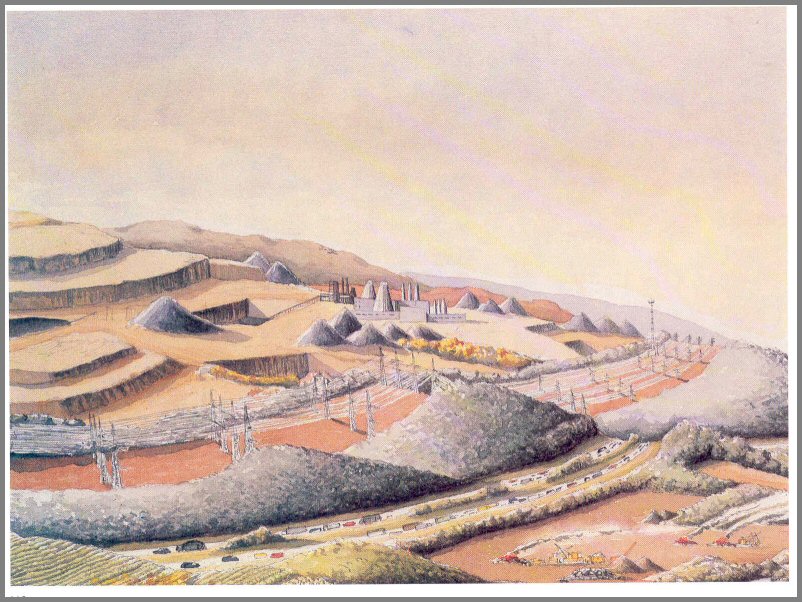
Page 112
IN YOUR ENVIRONMENTAL ARENA
What "manipulation" Fouls have been committed in your community?
Describe. some consequences of these Fouls.
How could they have been avoided?
How can they be corrected?
How would the "corrected" Fouls change lifestyles in the community?
How would your family's activities be affected?
Figure 45. - "Protecting" herds of grazing animals by removing their "predators" can backfire when competition by other grazers results in destruction of the natural range.
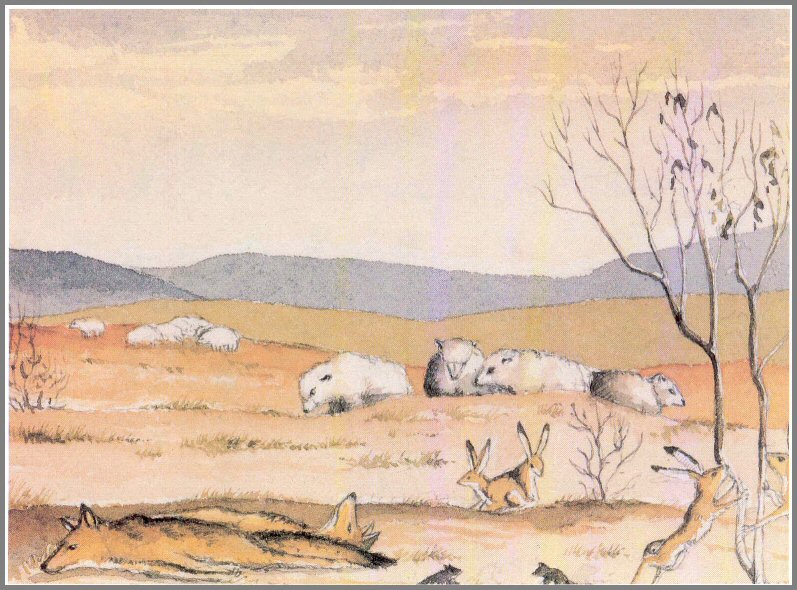
Page 113
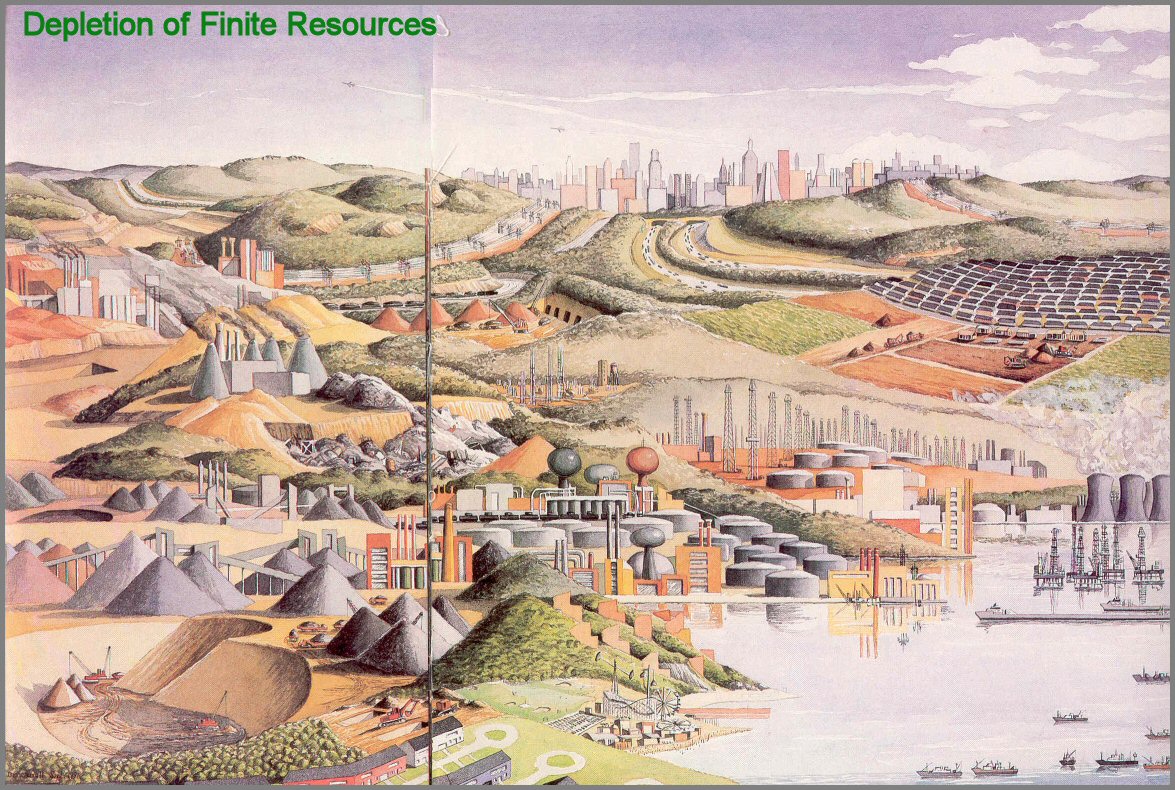
Page 114 - 115
Figure 46.
- Huge acreages of valuable agricultural land are lost each year to housing developments, highway, and industrialization.
Page 116